MARCH 2021 ENEWS
Dear friends of Salt Point and Fort Ross,
It does seem like we can begin to breathe a little more easily, with Sonoma County now in a lower Covid-19 tier and with that, some loosening of restrictions. We re-opened the Fort Ross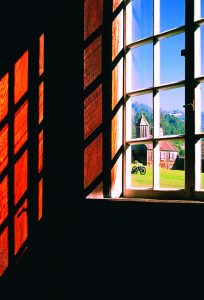 Visitor Center Museum at 25% capacity, and as of today the buildings within the historic compound are open at limited capacity -- you can once again explore the exhibitions or ascend the blockhouse tower to take in the spectacular coastal views.
Visitor Center Museum at 25% capacity, and as of today the buildings within the historic compound are open at limited capacity -- you can once again explore the exhibitions or ascend the blockhouse tower to take in the spectacular coastal views.
Every week FRC is getting many requests for private tours, which tells me visitors are anxious to get outside and start to explore the world again. It’s by no means over and California has a ways to go -- masks and social distancing are still required -- but it’s a huge relief to see small signs of normalcy.
Also in the plus column: on April 15th we are opening enrollment for our day & overnight Environmental Living 2020/2021 school program. While we don’t know exactly how overnight programs will look next school year, we share the teachers’ excitement about welcoming kids back to the park, and we will work together to create a safe outdoor teaching environment. For more information on onsite ELP programming at Fort Ross, contact Charon Vilnai at charonv@fortross.org.
These are experiences we want all kids to have. Thanks to our Fort Ross Education Fund we can offer fee waivers to schools and groups who couldn’t otherwise join us. We hope you help us spread the word!
Wishing you a healthy spring season -- do get outside to enjoy this marvelous season,
Sincerely,
Sarah
Sarah Sweedler
Fort Ross Conservancy CEO
Fort Ross Festival 2021 Canceled
We are disappointed to share with you that Fort Ross Festival 2021 is canceled due to Covid-19 restrictions. Fort Ross Festival brings over 3,000 people to the park and requires tremendous planning and engagement with both local and international performers, caterers, funders, and of course several hundred dedicated volunteers, and there is just too much pandemic uncertainty to know if we can plan for such a large gathering this summer.
What we do know: Mark your calendars for Fort Ross Festival 2022 on July 30th, 2022, when we will be throwing quite a welcome back party!
California’s Russian princess: Gagarina-Rotcheva
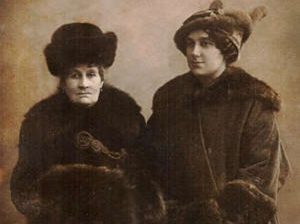 Princess Elena Pavlovna Gagarina-Rotcheva would go to the ends of the earth for her husband Alexander Rotchev, only to return to Russia from Alta California to serve orphans in Siberia - a duty which she faithfully began while at Fort Ross. She and her husband Alexander Rotchev lived at Ross from 1837 to 1841, during which time her husband, a man of letters, was appointed to manage and later liquidate the outpost.
Princess Elena Pavlovna Gagarina-Rotcheva would go to the ends of the earth for her husband Alexander Rotchev, only to return to Russia from Alta California to serve orphans in Siberia - a duty which she faithfully began while at Fort Ross. She and her husband Alexander Rotchev lived at Ross from 1837 to 1841, during which time her husband, a man of letters, was appointed to manage and later liquidate the outpost.
The well educated, multilingual, musical beauty was only 31 years young when Rotchev was entrusted by the Russian American Company (RAC) to administer Fort Ross and “in particular take care of the orphans, not trusting them to chance.” Gagarina’s parents had already rejected Rotchev as someone below their station, and less than a decade earlier Elena willfully walked away from her carefree, socialite life amid Moscow’s high society. She secretly married Rotchev in 1828, and soon eloped on an adventure of a lifetime with him to settle on the California frontier.
Being a mother of four, Gagarina-Rotcheva faithfully began to execute her duties at Ross, focusing on taking care of the orphans as well as the upbringing of the couple’s children -- Konstantin, Yelena, and infant Olga who was born in the middle of the ocean in March 1836 as the pair sailed to America; Rotchev enlisted in the Company’s service a year prior to provide for his family. Their eight-year-old son Mikhail, the eldest child who survived his brother Alexander who died in infancy in 1829, never lived in California, but rather was left in Sitka and later sent to St. Petersburg after Rotchev was ordered to take over managerial duties at Ross beginning from 1838.
The family’s deployment to California was no surprise because the couple has explicitly petitioned the Company to send them to Fort Ross for its “warm climate, abundant nature, and clear sky” that was to “buttress” Gagarina-Rotcheva’s health and provide a “salutary effect” for the creative spirit of Rotchev’s poetic soul. “I would not want to live here [Sitka] a long time; move us to Ross.... it would be easier to throw oneself from the first mountain into the sea than to condemn oneself to a long residence here [in Sitka],” Gagarina-Rotcheva stressed in her plea to RAC’s management. From the outset, California’s beauty and Ross’ solitude must have met the poet’s expectations. In 1836, during his initial introduction to RAC’s southmost outpost with Fr. Ioann Veniaminov (later St. Innocent of Alaska) the priest came to perform services at the first Orthodox parish in the continental United States. It is during this first visit to the outpost that construction of the Rotchev House, the only original Russian-period building still standing inside the stockade, began, in an attempt to match the comfort the pair was accustomed to in Russia. In addition to their new home, the family was also offered a house in the orchard, above the main fort, as their “dacha” or summer residence.
The Rotchevs’ arrival brought an unprecedented level of style and hospitality to the Russian frontier that was noted throughout the region and which opened many diplomatic doors, including those of Don Mariano Guadalupe Vallejo and Captain John Sutter, who eventually purchased the Russian holdings in 1841. “The mistress of the house, a young and gracious lady with a good figure and distinguished manners, speaking fluent French, gave us the nicest and most eager welcome,” French explorer Eugène Duflot de Mofras noted during his sojourn at Fort Ross where he also praised Rotchevs’ "choice library, French wines, a piano, and a score of Mozart."
Life on the frontier, and care for the orphans, must have been a unique experience for Gagarina-Rotcheva, who managed to balance her duties to her family and those demanded by the outpost with some style, despite a noticeable downturn in her relations with her husband: Alexander Rotchev and the family’s servant Agafia Ivanova had an illegitimate child while at Ross. After Rotchev liquidated Fort Ross, his wife and children returned to St. Petersburg via Alaska where the couple got a divorce.
Following her divorce, Gagarina-Rotcheva moved to the Siberian city of Irkutsk where she became the manager of an orphanage, appointed by the Empress of Russia. As the head of the institution, she improved and perfected an entire educational process. As an experienced teacher, she treated children with love and attention, trying to instill in them an interest in knowledge and the ability to think independently. She launched literary evenings and amateur theatre performances which quickly became known for their lively discussions of liberal ideas. In 1863, having served eight years as the administrator of the orphanage, Gagarina-Rotcheva retired and moved to current-day Ukraine to live with her daughter Olga who was born crossing the Atlantic. The noblewoman died in 1880 in the village of Chorbovka in the Poltava region. “Elena Gagarina lived in Chorbovka for 12 years,” the head of the village, Lyubov Vasyuta, recently told the Ukrainian Komsomolskaya Pravda (KP) news outlet. “She died in Poltava. But they buried her here in the Church of the Holy Spirit. The 75-year-old princess was buried with honors, the coffin was delivered from Poltava on a troika of white horses.”
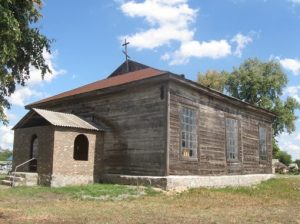
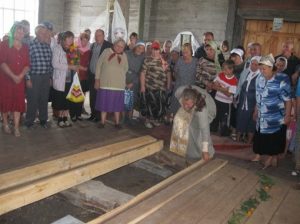
For over a century the final resting place of one of California’s earliest benefactors was forgotten. When descendants tried to inquire about the location of the grave from the Soviet authorities in the 1960s, they were told that the church where she was interred did not survive. Frustrated by the answer received, the family abandoned the search. It took another half a century for the family to rediscover the location of Gagarina-Rotcheva’s grave. And it came as a complete surprise.
Ten years ago one of the locals snuck into an old church to strip and salvage the wooden floors, but once he opened the coverings he reportedly stumbled upon the alleged burial place of a woman, and fled the scene. That same day he died in a motorcycle crash, prompting rumors of the Princess’s curse.
“When he [intruder] was buried, one old woman lamented at the cemetery that ‘she saw Princess Gagarina in a dream, and she promised to take revenge on everyone who dared to disturb her peace,’” local historian Konstantin Bobrishchev told the Komsomolskaya Pravda, providing images of the final resting place of Elena Gagarina-Rotcheva, a lady who took pride in taking care of the orphans in the US and in Russia.
- Igor Polishchuk, Director of External Relations
So Long, Scurvy!
 With recent rains pouring down on our stretch of the California coast, the earth has sprung to life in glorious green abundance. A closeup look reveals a mix of the grasses, wildflowers and plants that blanket the bluffs and hillsides. While many of these plants found their way here from Eurasia and are now part of our natural landscape, miner’s lettuce (Claytonia perfoliatai) is unusual in that it is a native green that was brought from California to Europe. It’s also easily found and foraged and makes a wonderful late winter and springtime salad. Freely picked and easily enjoyed, miner’s lettuce is a plant worth getting to know. Miner’s lettuce is a tender, annual herb that is rich in vitamin C. The common name ‘miner's lettuce’ refers to the California Gold Rush miners who ate this wild plant to prevent scurvy, a nasty and potentially fatal affliction caused by a severe vitamin C deficiency. One of the main goals of the Russian American Company’s Fort Ross settlement was to grow fresh fruits and vegetables to send to the Russian settlers in Alaska where many settlers suffered from this awful disease. Employees of Ross worked hard to produce food to send to the northern settlements, for example by establishing the (now historic) Fort Ross orchard in 1814 which park visitors continue to enjoy today. While the orchard happily produced peaches, apples, pears, cherries and quince, I can’t help but wonder if the Russians knew that growing wild all around them was the low-lying and humble, yet vitamin C-rich miner’s lettuce. If the Russians did make use of this succulent herb they certainly weren’t the first. Many California native peoples have been eating miner’s lettuce for countless years. In fact, another common name for miner’s lettuce is ‘Indian lettuce,' and it's listed as one of the Pomo peoples’ “chief plant foods” by Vinson Brown and Douglas Andrews in The Pomo Indians of California and Their Neighbors. And according to Matt Ritter, author of California Plants: A Guide to Our Iconic Flora, “[miner's lettuce]...can be recognized by the fused pair of succulent leaves that create a disk encircling the stem. Its white or pink flowers sit above the disk leaves, which are edible and were eaten raw or boiled by Native Americans…” Miner’s lettuce is considered a very common and easily foraged edible plant across California. It can grow up to 1.3 ft tall by 1 ft wide and has very distinct green cuplike leaves, and flowers from February to May. Both leaves and flowers are edible and make a wonderful base for a fresh spring salad. If you are interested in exploring miner’s lettuce you won’t have to look hard. According to University of California Agriculture and Natural Resources, habitat for this plant includes: chaparral, oak, woodlands, forests, and coastal sage scrub, agronomic and vegetable crop fields, orchards, vineyards, gardens, yards, and other disturbed sites. Since miner’s lettuce thrives in so many habitats, there is usually a wide-ranging abundance of this tender green to forage year after year. It is important to note, however, that this readily available herb can occasionally accumulate soluble oxalates--such as found in spinach--that may be toxic when eaten. This is a good reminder that doing your research before gathering plants from the wild is essential to avoid potential health hazards. Foraging is not allowed inside the park boundaries, and this basket of freshly picked greens--miner’s lettuce and chickweed--was taken a few short miles north of Fort Ross State Historic Park. Many plants that grow in abundance here, like chickweed, were brought from Eurasia and have since naturalized in the Golden State. Miner’s lettuce is special, since it is a California native that can now be found growing in Europe. While it’s unclear who first brought this plant overseas, according to Hank Shaw, writer for The Atlantic, we know that early explorers were so impressed by the rich nutrient content of this little plant that they saved the seeds to bring back with them on their voyages home. Although some pieces of the miner’s lettuce story are unclear, what is clear is that this edible California native plant is an easily foraged, tender herb, that has long been providing an important food source for many. This spring say hello miner’s lettuce, and so long scurvy! And, don’t forget to come visit Fort Ross and Salt Point to see the impressive variety of plant life thriving at your favorite coastal parks.
With recent rains pouring down on our stretch of the California coast, the earth has sprung to life in glorious green abundance. A closeup look reveals a mix of the grasses, wildflowers and plants that blanket the bluffs and hillsides. While many of these plants found their way here from Eurasia and are now part of our natural landscape, miner’s lettuce (Claytonia perfoliatai) is unusual in that it is a native green that was brought from California to Europe. It’s also easily found and foraged and makes a wonderful late winter and springtime salad. Freely picked and easily enjoyed, miner’s lettuce is a plant worth getting to know. Miner’s lettuce is a tender, annual herb that is rich in vitamin C. The common name ‘miner's lettuce’ refers to the California Gold Rush miners who ate this wild plant to prevent scurvy, a nasty and potentially fatal affliction caused by a severe vitamin C deficiency. One of the main goals of the Russian American Company’s Fort Ross settlement was to grow fresh fruits and vegetables to send to the Russian settlers in Alaska where many settlers suffered from this awful disease. Employees of Ross worked hard to produce food to send to the northern settlements, for example by establishing the (now historic) Fort Ross orchard in 1814 which park visitors continue to enjoy today. While the orchard happily produced peaches, apples, pears, cherries and quince, I can’t help but wonder if the Russians knew that growing wild all around them was the low-lying and humble, yet vitamin C-rich miner’s lettuce. If the Russians did make use of this succulent herb they certainly weren’t the first. Many California native peoples have been eating miner’s lettuce for countless years. In fact, another common name for miner’s lettuce is ‘Indian lettuce,' and it's listed as one of the Pomo peoples’ “chief plant foods” by Vinson Brown and Douglas Andrews in The Pomo Indians of California and Their Neighbors. And according to Matt Ritter, author of California Plants: A Guide to Our Iconic Flora, “[miner's lettuce]...can be recognized by the fused pair of succulent leaves that create a disk encircling the stem. Its white or pink flowers sit above the disk leaves, which are edible and were eaten raw or boiled by Native Americans…” Miner’s lettuce is considered a very common and easily foraged edible plant across California. It can grow up to 1.3 ft tall by 1 ft wide and has very distinct green cuplike leaves, and flowers from February to May. Both leaves and flowers are edible and make a wonderful base for a fresh spring salad. If you are interested in exploring miner’s lettuce you won’t have to look hard. According to University of California Agriculture and Natural Resources, habitat for this plant includes: chaparral, oak, woodlands, forests, and coastal sage scrub, agronomic and vegetable crop fields, orchards, vineyards, gardens, yards, and other disturbed sites. Since miner’s lettuce thrives in so many habitats, there is usually a wide-ranging abundance of this tender green to forage year after year. It is important to note, however, that this readily available herb can occasionally accumulate soluble oxalates--such as found in spinach--that may be toxic when eaten. This is a good reminder that doing your research before gathering plants from the wild is essential to avoid potential health hazards. Foraging is not allowed inside the park boundaries, and this basket of freshly picked greens--miner’s lettuce and chickweed--was taken a few short miles north of Fort Ross State Historic Park. Many plants that grow in abundance here, like chickweed, were brought from Eurasia and have since naturalized in the Golden State. Miner’s lettuce is special, since it is a California native that can now be found growing in Europe. While it’s unclear who first brought this plant overseas, according to Hank Shaw, writer for The Atlantic, we know that early explorers were so impressed by the rich nutrient content of this little plant that they saved the seeds to bring back with them on their voyages home. Although some pieces of the miner’s lettuce story are unclear, what is clear is that this edible California native plant is an easily foraged, tender herb, that has long been providing an important food source for many. This spring say hello miner’s lettuce, and so long scurvy! And, don’t forget to come visit Fort Ross and Salt Point to see the impressive variety of plant life thriving at your favorite coastal parks.
--Charon Vilnai, ELP Program Manager, Bookshop Manager, Sea Lion Survey Project Lead, and Call House Museum Lead
Fort Ross Conservancy Members’ Meeting: April 24th at 10am Pacific Time
Dear FRC Members,
We hope you are doing well and staying healthy. Fort Ross Conservancy's Annual Members' Meeting will be held online this year. We will present our Fort Ross Conservancy annual report via Zoom on Saturday, April 24th, 2021, at 10am. We will offer both a Zoom meeting with visuals and an audio-only call-in option. If you wish to attend please RSVP to Sarjan Holt at sarjanh@fortross.org.
As a public charity, Fort Ross Conservancy holds these meetings with the goal of updating our membership on all important items related to Fort Ross Conservancy. We will provide an overview of programming and our financial status from 2020 and present our goals for the new year.
Looking forward to hearing from you at our online meeting on April 24th, 2020.
Sincerely,
Sarah Sweedler
Fort Ross Conservancy CEO
Remembering Elsa
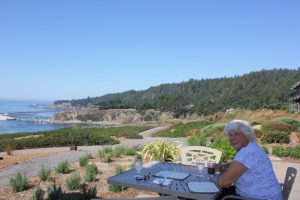
It is with sadness that we learned of our long-time volunteer, FRC member, and dear friend Elsa Barry’s passing. Elsa spent many years camping at Salt Point and volunteering at the Fort Ross bookshop, working with us well into her 90s. She loved the Sonoma coast. Everyone with parks knew her, enjoyed her help and company. I enjoyed listening to her many stories from her colorful life. She never ended a tale without punctuating it with a funny last word and leaving us with a parting quip: “Time to go! It is cocktail hour!” She was energetic, candid, unapologetic, quick witted and always cheerful. She had a wicked sense of humor and a no-nonsense outlook on life. She was a good judge of character, and not much escaped her. I will miss Elsa and will always remember her fondly.
Elsa, you are no longer with us. I am thinking that it must be cocktail hour in Heaven.
-Sarjan Holt, Operations Manager